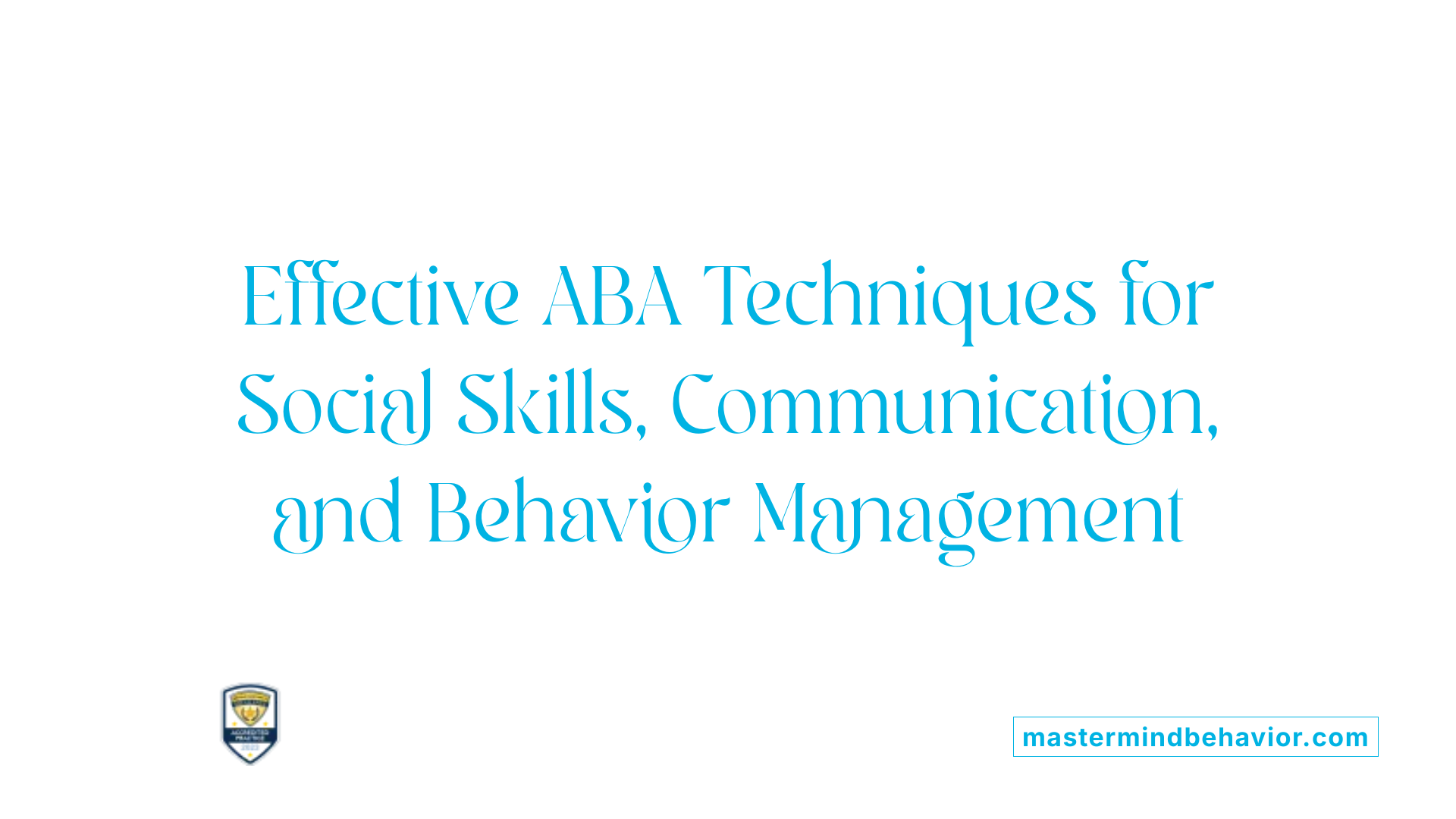How ABA Therapy Supports Children During Community Events

Understanding ABA Therapy and Its Role in Community Engagement
Applied Behavior Analysis (ABA) therapy is an evidence-based intervention widely recognized for its effectiveness in supporting children with autism spectrum disorder (ASD). Rooted in behavioral science, ABA employs individualized strategies to enhance communication, social skills, and independence while reducing challenging behaviors. This article explores how ABA therapy specifically aids children during community events — environments that can pose social and sensory challenges but also offer vital learning and growth opportunities.
What Is Applied Behavior Analysis (ABA) Therapy?

What is Applied Behavior Analysis (ABA) therapy?
Applied Behavior Analysis (ABA) therapy is a scientifically-based approach designed to help individuals, particularly those with autism spectrum disorder (ASD), improve essential skills and reduce challenging behaviors. It relies on understanding how behaviors function and using evidence-based techniques like positive reinforcement to encourage desirable behaviors while minimizing undesirable ones.
How are ABA treatment plans individualized?
ABA therapy is highly personalized. Each treatment plan is tailored to an individual's unique strengths, challenges, and needs. Therapy goals focus on improving communication, social skills, daily living activities, and academic performance. This customization ensures that interventions target the most meaningful and functional behaviors for each person.
What role do Board Certified Behavior Analysts (BCBAs) play?
Certified professionals known as BCBAs carefully design, implement, and supervise ABA programs. They conduct detailed assessments to understand behavior triggers and consequences, then develop structured treatment plans. BCBAs also oversee therapy delivery, adjusting strategies to maximize progress and generalization across different environments such as home, school, and community.
What skills does ABA therapy target?
ABA therapy emphasizes several key areas:
- Communication: Enhancing verbal, nonverbal, and alternative communication methods like sign language or devices.
- Social Skills: Developing abilities such as initiating conversations, taking turns, sharing, and reading body language.
- Daily Living Skills: Teaching independence through tasks like dressing, grooming, toileting, and eating.
- Behavior Management: Reducing problematic behaviors such as aggression and tantrums by identifying triggers and teaching positive alternatives.
- Academic Readiness: Improving attention, memory, and the ability to follow instructions that support school success.
How flexible is ABA therapy across different settings?
ABA therapy is adaptable and can be delivered in various environments including homes, schools, clinics, and community settings. This flexibility helps children apply learned skills in real-world situations, promoting generalization and long-term success. Family involvement is also encouraged to support maintenance of skills and progress beyond therapy sessions.
How ABA Therapy Benefits Individuals with Autism in Community Settings

How does ABA therapy benefit individuals with autism?
ABA therapy scientifically enhances beneficial behaviors in individuals with autism, such as communication and social skills, while effectively reducing challenging behaviors. Through personalized and structured approaches like positive reinforcement and behavioral analysis, therapy plans are tailored to meet each individual's unique needs. Early intervention, ideally before age six, leads to notable developmental improvements and less dependence on special services later.
Improvements in communication and social skills
ABA therapy promotes both verbal and nonverbal communication, enabling children to express themselves clearly using speech, sign language, or communication devices. It teaches social skills including initiating conversations, responding appropriately, sharing, making eye contact, and understanding nonverbal cues. These skills help children navigate social environments confidently, fostering meaningful interactions in community settings.
Reduction of challenging behaviors in social environments
This therapy identifies triggers for behaviors like tantrums, aggression, and repetitive actions. By understanding these causes, ABA uses evidence-based strategies to teach alternative, positive behaviors. In social situations, this results in fewer disruptions, improved interactions, and increased comfort for the individual and those around them.
Enhancement of emotional regulation
ABA supports children in recognizing and managing their emotions, helping them respond appropriately in challenging situations. This emotional regulation improves their ability to handle stress or frustration during community activities, leading to more positive social experiences.
Promotion of independence through life skills
Through ABA, individuals learn essential life skills such as dressing, grooming, eating, and personal hygiene. These lessons empower children to become more self-reliant and confident when participating in community events, enhancing their overall quality of life.
Importance of early and ongoing intervention
Starting ABA therapy early, preferably between ages two and six, is critical for optimal outcomes. Continuous intervention through childhood and even adulthood ensures that skills are maintained and adapted as new social challenges arise, supporting lifelong success in community participation.
Key ABA Techniques Applied During Community Events

What techniques are commonly used in ABA therapy?
ABA therapy employs a variety of well-established techniques designed to support behavioral change and skill acquisition, especially in real-world contexts like community events.
One fundamental method is positive reinforcement, which involves encouraging desired behaviors by offering rewards or praise in public settings. This approach helps children associate positive outcomes with appropriate actions, increasing the likelihood of repeating them.
Prompting and fading are also essential. These involve guiding the child through a task using verbal or physical hints (prompting) and then gradually withdrawing these cues (fading) to promote independent skill use.
Discrete Trial Training (DTT) breaks complex skills into small, manageable steps and offers structured, repeated opportunities to practice these skills even in natural environments, such as during community outings.
Behavior chaining is particularly useful for mastering complex social tasks, such as initiating conversations or following multi-step instructions. This method teaches each link of a sequence step-by-step until the entire behavior chain is performed independently.
Modeling appropriate social behaviors is another strategy, where therapists or peers demonstrate desired actions—like sharing or taking turns—giving children a clear example to imitate.
These techniques, often combined and tailored to each child's unique needs, leverage the principles of reinforcement and systematic instruction to promote social skills, communication, and independence across various settings. Their efficacy is backed by extensive research, making them a cornerstone of community-focused ABA interventions.
Who Provides ABA Therapy and How Services Adapt to Community Involvement

Who typically provides ABA therapy services?
ABA therapy is typically provided by a team of qualified professionals including Board Certified Behavior Analysts (BCBAs), licensed psychologists, and trained behavior therapists. These experts design and oversee personalized treatment plans that focus on enhancing communication, social skills, daily living abilities, and reducing challenging behaviors in children with autism. In many cases, services are delivered by specialized companies or clinics staffed with well-trained therapists under BCBA supervision to ensure consistent and effective intervention.
How is ABA therapy delivered across different settings?
ABA therapy adapts to the child's environment and needs, and it is commonly provided in the home, school, and community settings. This flexibility helps generalize skills across multiple environments for lasting impact. Home sessions often address everyday skills and family routines, school-based therapy supports academic success and social integration, while community sessions foster safety awareness and social interactions in real-world situations.
What is the importance of supervision and ongoing assessment?
Continuous supervision by BCBAs is essential to maintain high-quality ABA services. BCBAs regularly assess progress and adapt treatment plans to suit changing needs. This ongoing review allows for effective, individualized care and ensures that therapy goals remain aligned with the child’s development.
How do specialized therapy companies and clinics contribute?
Specialized therapy companies and clinics play a crucial role by employing trained therapists and providing structured programs following established ABA principles. These organizations offer consistent staff training and program evaluation, creating a supportive community framework that helps families access comprehensive ABA services.
What role do families have in ABA therapy?
Family involvement is vital to the success of ABA. Therapists work closely with parents and caregivers, offering training and regular updates so families can reinforce skills and maintain progress outside sessions. Active family participation helps create a supportive environment where learned behaviors can thrive, promoting meaningful, lifelong improvements.
Promoting Social Interaction and Communication at Community Events

Teaching Initiation and Response Skills
ABA therapy helps children with autism learn how to start conversations and respond appropriately to others. These initiation and response skills are crucial for engaging in meaningful interactions at community events where social exchange is constant.
Understanding and Using Non-Verbal Cues
Children are taught to recognize and interpret non-verbal signals such as facial expressions, gestures, and body language. This understanding supports smoother communication and helps them respond correctly to social cues in various settings.
Practicing Turn-Taking and Sharing
Structured practice through ABA focuses on essential social skills like turn-taking and sharing. These skills are practiced both in controlled environments and during real-life scenarios, including community gatherings, enabling children to participate successfully in group activities.
Communication Via Speech, Sign, and Devices
ABA therapy supports diverse communication methods tailored to each child's needs, including spoken language, sign language, and the use of communication devices. This flexibility allows children to effectively express their needs and thoughts during public events.
Building Confidence in Social Navigation
By mastering social initiation, responses, non-verbal cues, and cooperative behaviors, children gradually build confidence. This confidence helps them navigate community events more independently and enjoy social experiences with less anxiety.
ABA's personalized, evidence-based approach ensures that these skills are taught systematically and generalized across settings such as home, school, and community, fostering meaningful participation in public social activities.
Addressing Challenging Behaviors and Safety in Public Settings
How Are Behavior Triggers Identified in Community Events?
ABA therapy begins by carefully identifying triggers that cause challenging behaviors, especially in settings like community events. Therapists observe the child's reactions to different stimuli—such as noise, crowds, or unfamiliar environments—to pinpoint specific causes. This detailed understanding allows for targeted strategies that reduce distress and prevent escalation.
What Is the Role of Functional Behavior Assessments?
Functional Behavior Assessments (FBAs) play a crucial role in understanding why certain negative behaviors occur. FBAs analyze the purpose behind behaviors such as tantrums or aggression by examining what the child gains or avoids through these actions. This insight informs the development of personalized interventions that address the root cause rather than just the symptoms.
How Does ABA Teach Alternative Positive Behaviors?
Once triggers and functions of behaviors are understood, ABA therapists teach alternative, positive behaviors to replace challenging ones. Techniques like prompting and reinforcement encourage children to use skills such as requesting breaks, using words or communication devices, and engaging in calming activities. These replacements provide functional ways to express needs or cope with stress.
What Emotional Regulation Techniques Are Used?
ABA therapy includes emotional regulation training to help children recognize and manage feelings effectively. Children learn to identify early signs of frustration or anxiety and apply coping strategies like deep breathing, counting, or requesting support. Improving emotional awareness helps reduce problem behaviors and enhances responses to challenging situations.
How Does ABA Enhance Safety Awareness and Boundary Recognition?
Safety is paramount during community outings. ABA programs teach children to recognize potential dangers, understand personal boundaries, and use safe practices like asking for help or avoiding hazardous areas. Skills are practiced repeatedly in various environments to ensure children generalize safety behaviors across home, school, and public settings.
Overall, through individualized plans that combine assessment, skill-building, and reinforcement, ABA therapy empowers children with autism to handle challenging behaviors and stay safe during public activities.
Fostering Independence Through Life Skills Training in the Community
Teaching Dressing, Hygiene, and Toileting
ABA therapy emphasizes teaching essential life skills such as dressing, hygiene, and toileting to help children with autism gain independence. Through structured and repetitive practice, children learn these routines in a step-by-step manner that suits their individual needs. This targeted approach enables children to gradually master self-care tasks, promoting greater confidence and autonomy.
Decision-Making Skills
Beyond basic self-care, ABA assists in developing decision-making skills. Children are supported to make choices in everyday situations, fostering critical thinking and problem-solving. These skills enhance their capacity to handle daily challenges and promote responsible independence both at home and in the community.
Practice of Daily Living Tasks in Public
ABA therapy includes opportunities for children to practice daily living tasks outside the home, such as at schools, shops, or parks. This real-world practice is vital for generalizing skills learned in structured settings to community environments. For example, children might work on payment transactions or ask for assistance in public, which helps build confidence and practical competence.
Importance of Generalization Across Environments
Generalization—the ability to use learned skills in different settings—is a central goal of ABA. Therapists and caregivers work collaboratively to ensure that skills are transferred from therapy sessions to various environments like home, school, and community. This consistency across environments strengthens learning and supports lasting independence.
Increasing Child Autonomy During Events
ABA also promotes autonomy by encouraging children to participate actively during family or community events. Children learn how to navigate social situations, manage routines, and make choices within these settings. Gradually increasing responsibility boosts their self-reliance and comfort in less structured environments.
By systematically addressing these areas, ABA therapy equips children with autism to live more independently and confidently, preparing them for broader social participation and life successes.
Family Involvement and Collaboration During Community Experiences
Training and Support for Parents
Families play a crucial role in ABA therapy by receiving training and ongoing support. Therapists and behavior analysts provide parents with the knowledge and tools needed to reinforce skills learned during therapy sessions. This collaborative effort empowers parents to confidently guide their children’s development outside clinical settings.
Family's Role in Skill Generalization
To help children apply their skills in everyday life, families are instrumental in promoting generalization. By practicing communication, social, and daily living skills across different community settings, family members help ensure these abilities become part of the child’s natural behavior.
Monitoring Therapy Progress Outside Clinical Settings
Parents actively monitor their child’s progress during community experiences, observing how skills are used in real-world environments. This ongoing supervision helps identify successes as well as areas needing reinforcement or adjustment, enhancing the effectiveness of ABA interventions.
Importance of Family Feedback to Therapists
Regular communication between families and therapists is vital. Family feedback regarding the child's behavior and progress in daily life informs treatment planning, ensuring that therapy remains personalized and effective across contexts.
Creating Consistent Routines and Reinforcement
Families contribute by establishing consistent routines and reinforcement strategies at home and in the community. Consistency in expectations and positive reinforcement encourages the child to maintain and build on skills learned in therapy, supporting long-term success.
Enhancing Community Participation Through ABA
ABA therapy equips children with autism spectrum disorder with critical tools to navigate community events successfully. By improving communication, social interaction, emotional regulation, and independence, ABA fosters meaningful participation in social settings. The collaboration between qualified professionals and families ensures individualized, supportive interventions that translate across environments. These strengths empower children to enjoy community experiences with greater confidence and engagement, highlighting ABA's vital role beyond clinical boundaries.
References
- 5 Benefits of ABA Therapy for Autistic Child
- Benefits of ABA Therapy for Children with Autism
- Applied Behaviour Analysis (ABA) and autistic children
- 6 Life-Changing Benefits of ABA Therapy for Children ... - Linx
- Applied Behavior Analysis (ABA)
- Applied Behavior Analysis (ABA)
- Applied Behavior Analysis
- Applied Behavior Analysis (ABA)
- Applied Behavior Analysis (ABA)
Recent articles

Helping Children With Autism Develop Self-Help Skills At Home
Enhancing Independence Through At-Home Strategies for Children With Autism

Understanding What Is ABA: Principles Families Should Know
Unlocking the Power of ABA in Autism Support

Teaching Organizational Skills Using ABA Approaches
Effective Strategies for Teaching Organization with ABA

How ABA Therapy Improves Transitions Between School Activities
Enhancing School Transitions for Students with Autism

Teaching Self-Correction Skills Through ABA Techniques
Empowering Autism Interventions with Self-Correction Skills

How ABA Supports Social Communication In Group Settings
Enhancing Social Skills Through Evidence-Based Interventions



